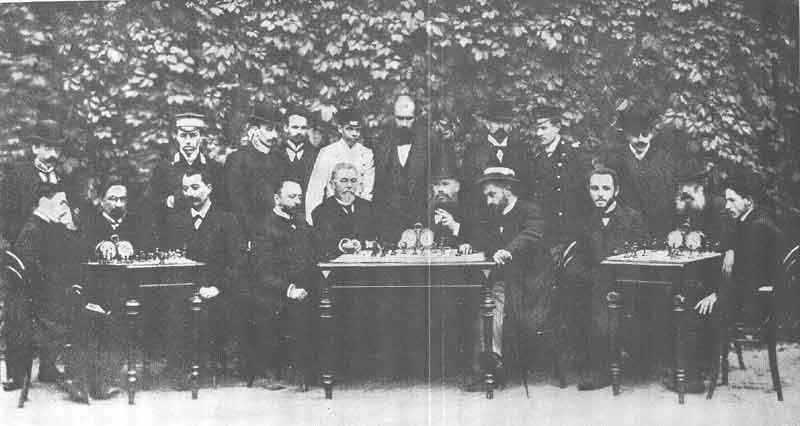
A Century of Chess; Vienna 1903
I haven’t said much in this series about Mikhail Chigorin, who was kind of the elder statesman of chess masters of this period, held in something of the same reverence that Keres or Bronstein would be for Soviet players in the ‘60s – at the point in time when Spassky claimed that Keres was ‘a giant among the Lilliputians.’ Part of the undertow of the classical era was a deep discontent with the ‘modern style’ – which was seen to be mechanical, unimaginative, cowardly, and unattractive. At the beginning of the 1900s, tournament organizers attempted changing the rules to penalize draws. A few years later, there was a phase of thematic tournaments. Vienna 1903 was the greatest of them – a genuinely world-class tournament, in which all games started with the position after 1.e4 e5 2.f4 exf4. This enforced return to Romanticism suited Chigorin perfectly – and he won Vienna 1903, his first tournament triumph in years, to the great satisfaction of the entire chess community. Frank Marshall, who finished a close second, wrote, “Coming second was no disgrace, for the old Russian had made a lifelong study of the King’s Gambit and had a deeper knowledge of this intricate opening than has ever been possessed by any other man.”

I’ve written a great deal, on the other hand, about Frank Marshall. His uneven ascent to the first rank of masters was sort of the main event in tournament chess of this period – and Vienna 1903 was a critical breakthrough for him. He had been in a bad slump since Paris 1900, seemed to be settling in as a dangerous but second-tier master, at the level more or less of Jacques Mieses. “No sooner had I received the invitation for Vienna,” he wrote in his autobiography, “than I felt that my luck was about to change.” At Vienna, he had full scope to employ his tactical imagination. He beat Pillsbury twice and might well have won the tournament if not for a crucial forfeit by Teichmann in his last-round game against Chigorin.

Georg Marco finished third in one of the best results of his career. Marco’s great strength was as an opening theoretician and the thematic tournament suited his analytical approach.
The use of the King’s Gambit wreaked some havoc on the usual tournament standings. The classical stalwarts – Maróczy, Schlechter, and Teichmann – all finished out of the money, although Maróczy had the consolation of winning the brilliancy prize.
Schlechter had probably the worst tournament of his career, finishing second-to-last with a score of -4. It’s rare, looking over a game, to actually feel the acute misery of the person who played it – and that’s clearly the case with Schlechter who was completely out of his element with the white pieces.
There are some interesting tidbits for King’s Gambiteers in playing over these games. Very popular was the Gianutio Countergambit, which I had never heard of (sometimes cross-referenced with the equally arcane-sounding Panteldakis Countergambit). In both variations black plays an early …f5 creating wild-looking positions. Marco’s success in this tournament was largely due to his ‘breaking’ the once-ferocious Muzio Gambit with 5…d5 followed by 6…gxf3 – he won three games against tough players by simply pocketing the extra piece and simplifying to the endgame.
Quaint as the thematic tournament might seem, the organizers had reason to be pleased with the event. The white side finished with a minus but far from shameful score of +33-36=20, which demonstrated that the King’s Gambit was still perfectly viable at the top level. The games were beautiful and hard-fought, with a very low percentage of draws.
